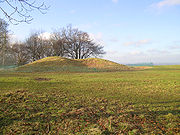
Oval barrow
Encyclopedia
An oval barrow is the name given by archaeologists to a type of prehistoric burial tumulus
of roughly oval shape.
In the British mid to late Neolithic
and early Bronze Age
, oval barrows may indicate a transition between earlier long barrow
s with multiple burials and the later, more individual round barrow
s.
Judging from those sited in or near the Thames Valley, there is much doubt as to how oval barrows are related to the burials found within them and funerary practices, because there can be a long gap of many years between an original burial and the construction of the barrow.
 The barrow held only one burial and radio-carbon dating has shown that the death, the burial and the building of the mound probably all took place within the period 3,750-3,100 B.C., but at different times within that period. The remains appeared to have been placed between two large vertical posts, 1.2 metres apart. Pottery shards and animal bones were found at the core of the mound and the excavators suggest that these came from ceremonial feasting when the mound was built.
The barrow held only one burial and radio-carbon dating has shown that the death, the burial and the building of the mound probably all took place within the period 3,750-3,100 B.C., but at different times within that period. The remains appeared to have been placed between two large vertical posts, 1.2 metres apart. Pottery shards and animal bones were found at the core of the mound and the excavators suggest that these came from ceremonial feasting when the mound was built.
Tumulus
A tumulus is a mound of earth and stones raised over a grave or graves. Tumuli are also known as barrows, burial mounds, Hügelgrab or kurgans, and can be found throughout much of the world. A tumulus composed largely or entirely of stones is usually referred to as a cairn...
of roughly oval shape.
In the British mid to late Neolithic
Neolithic
The Neolithic Age, Era, or Period, or New Stone Age, was a period in the development of human technology, beginning about 9500 BC in some parts of the Middle East, and later in other parts of the world. It is traditionally considered as the last part of the Stone Age...
and early Bronze Age
Bronze Age
The Bronze Age is a period characterized by the use of copper and its alloy bronze as the chief hard materials in the manufacture of some implements and weapons. Chronologically, it stands between the Stone Age and Iron Age...
, oval barrows may indicate a transition between earlier long barrow
Long barrow
A long barrow is a prehistoric monument dating to the early Neolithic period. They are rectangular or trapezoidal tumuli or earth mounds traditionally interpreted as collective tombs...
s with multiple burials and the later, more individual round barrow
Round barrow
Round barrows are one of the most common types of archaeological monuments. Although concentrated in Europe they are found in many parts of the world because of their simple construction and universal purpose....
s.
Judging from those sited in or near the Thames Valley, there is much doubt as to how oval barrows are related to the burials found within them and funerary practices, because there can be a long gap of many years between an original burial and the construction of the barrow.
Whiteleaf Hill
There is a neolithic oval barrow near the top of Whiteleaf Hill, Monks Risborough, Buckinghamshire (National Grid: SP 822040), which was first excavated by Sir Lindsay Scott between 1934 and 1939 and re-excavated from 2002 to 2006 by Oxford Archaeology (assisted by the Princes Risborough Countryside Group). The mound is roughly oval, but indented on the north-eastern side, making it somewhat kidney-shaped.

